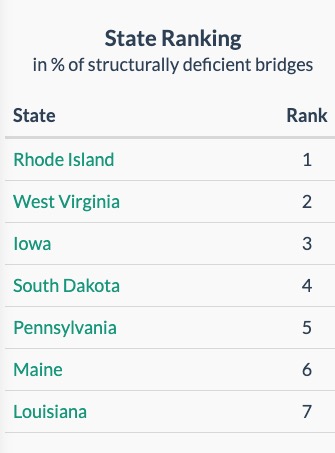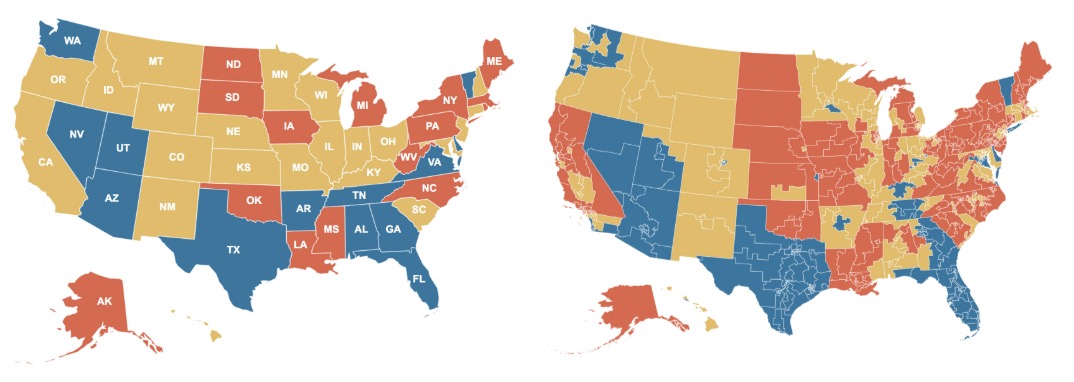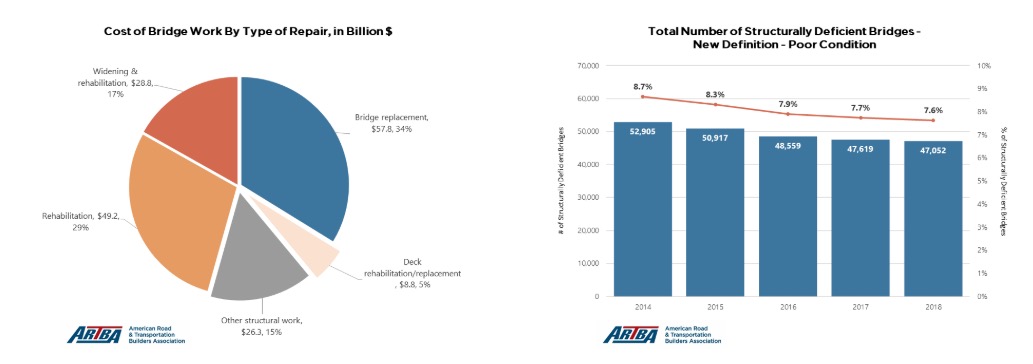AMERICAN ROAD & TRANSPORTATION BUILDERS ASSOCIATION (ARTBA)
47,000 U.S Bridges in Poor Condition & Pace of Repair Slows to Crawl
Highlights
- 47,052 of America’s 616,087 bridges are rated “structurally deficient” and need urgent repairs.
- The pace of repair in 2018 slowed compared to previous years—with only a 1 percent net reduction of deficient structures.
- Americans cross these deficient bridges 178 million times a day.
- Average age of a structurally deficient bridge is 62 years, compared to 40 years for non-deficient bridges.
- 235,020 (38 percent) of U.S. bridges have identified repair needs.
- 18,842 (1 in 3) Interstate highway bridges have identified repair needs.
- State by state details: artbabridgereport.org
There are 47,052 bridges classified as structurally deficient and considered to be in poor condition, according to a new ARTBA analysis of the recently released U.S. Department of Transportation’s 2018 National Bridge Inventory (NBI) database. If placed end-to-end, they would stretch nearly 1,100 miles—the distance between Chicago and Houston.
Cars, trucks and school buses cross these 47,052 compromised structures 178 million times every day, the data show.
Although the number of structurally deficient bridges is down compared to 2017, the pace of improvement has slowed compared to the last five years. At this rate, it would take over 80 years to make the significant repairs needed on these structures.
Including structurally deficient bridges, there are nearly 235,000 bridges across the country that need structural repair, rehabilitation or replacement, according to ARTBA’s analysis of the NBI data, accounting for 38 percent of all bridges. ARTBA estimates the cost to make the identified repairs for all 235,000 bridges is nearly $171 billion, based on average cost data published by FHWA.
What’s New
Effective Jan. 1, 2018, FHWA changed the definition of structurally deficient as part of the final rule on highway and bridge performance measures, published May 20, 2017, pursuant to the 2012 federal aid highway bill Moving Ahead for Progress in the 21st Century Act (MAP-21). Two measures that were previously used to classify bridges as structurally deficient are no longer used. This includes bridges where the overall structural evaluation was rated in poor or worse condition, or with insufficient waterway openings.
The new definition limits the classification to bridges where one of the key structural elements—the deck, superstructure, substructure or culverts—are rated in poor or worse condition. Based on the new definition of structurally deficient, there are 6,533 bridges that would have been classified as structurally deficient in 2017, but did not meet the new criteria in 2018.
Bridge ratings are updated as inspections are completed—each year some bridges are classified as structurally deficient and others are removed from that category as they undergo repair, rehabilitation or replacement. Nearly 88 percent of the bridges classified as structurally deficient in 2018 had the same rating in 2017. There were 5,660 bridges newly classified as structurally deficient in 2018. Another 6,229 bridges that were structurally deficient in 2017 were removed from that category in 2018, for an overall net decline of 567 bridges.
This pace of the work is at the slowest point in five years—between 2014 and 2017 the total number of structurally deficient bridges fell by an average of 1,700 each year.
Notable Bridges
Nearly two-third of the bridges that are structurally deficient in 2018 have been classified as structurally deficient since 2014. Some of the notable structurally deficient bridges in 2018 include:
- New York’s Brooklyn Bridge;
- Memorial Bridge connecting Washington, D.C. at the Lincoln Memorial with Arlington, Va.;
- San Mateo-Hayward bridge crossing California’s San Francisco Bay – the longest bridge in California;
- Robert S. Maestri Bridge over Lake Pontchartrain in Louisiana;
- Albemarle Sound Bridge and the Lindsay C. Warren Bridge crossing the Alligator River in N.C.;
- Florida’s Pensacola Bay Bridge;
- Vicksburg Bridge in Miss.; and
- Lacey V. Murrow Memorial Bridge in Washington state.
The most traveled structurally deficient bridges are on parts of Route 101, Interstate 405 and Interstate 5 in California, where daily crossings are as high as 289,000 per day.
Rankings
 The states with the most structurally deficient bridges, as a percent of their total bridge inventory, are: Rhode Island (23 percent); West Virginia (19.8 percent); Iowa (19.3 percent); South Dakota (16.7 percent); Pennsylvania (16.5 percent); Maine (13.1 percent); Louisiana (13 percent); Puerto Rico (11.7 percent); Oklahoma (10.9 percent); and North Dakota (10.7 percent).
The states with the most structurally deficient bridges, as a percent of their total bridge inventory, are: Rhode Island (23 percent); West Virginia (19.8 percent); Iowa (19.3 percent); South Dakota (16.7 percent); Pennsylvania (16.5 percent); Maine (13.1 percent); Louisiana (13 percent); Puerto Rico (11.7 percent); Oklahoma (10.9 percent); and North Dakota (10.7 percent).
States with the largest number of structurally deficient bridges are: Iowa (4,675 bridges); Pennsylvania (3,770); Oklahoma (2,540); Illinois (2,273); Missouri (2,116); North Carolina (1,871); California (1,812); New York (1,757); Louisiana (1,678); and Mississippi (1,603).
While these bridges may not be imminently unsafe, they are in need of attention. Nearly 69,000 bridges across the country are “posted for load” which means there are weight restrictions or other measures in place to reduce stress on the structure.
Over the last five years, Pennsylvania has reduced the number of its structurally deficient bridges by 1,199. Other states with large decreases: Oklahoma (900); Indiana (593); California (576) and Ohio (499). In 14 states, the number of structurally deficient bridges actually increased over the five years, including: West Virginia (plus 522); Illinois (159); Florida (109); Montana (106) and Louisiana (69).
State—and congressional district—specific information from the analysis—including rankings and the locations of the 250 most heavily travelled structurally deficient bridges in the nation and top 25 most heavily traveled in each state—is available at artbabridgereport.org.
View full version online (artba.org): ARTBA 2019 Bridge Report
About the American Road & Transportation Builders Association
www.artba.org
The Washington, D.C.-based American Road & Transportation Builders Association (ARTBA) is a non-partisan federation whose primary goal is to aggressively grow and protect transportation infrastructure investment to meet the public and business demand for safe and efficient travel.
Tags: American Road & Transportation Builders Association, ARTBA, Structurally Deficient Bridges Report








 RSS Feed
RSS Feed